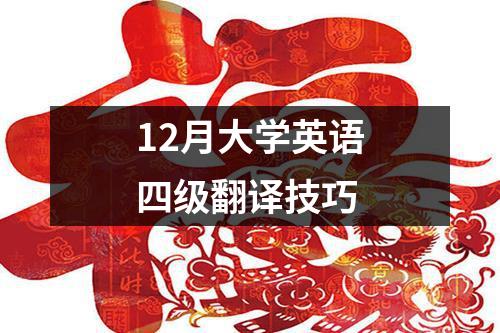12月大学英语四级翻译技巧
- 作文大全
- 2024-06-14
- 167热度
- 0评论
以下是小编为大家准备的12月大学英语四级翻译技巧,本文共11篇,仅供参考,欢迎大家阅读。

1.理解为首要原则
拿到翻译题之后,先确定原句的意思。如果句子较长,可以先找主、谓、宾、定、状、补,分析清楚句子结构,然后再理解。
很多考生过分侧重对翻译技巧的训练,拿着翻译题就一味想着把英文往中文里套,却没有意识到自己对原文的理解实际上就有偏差,这就很难得到理想的分数了。
2. 几种变通手段
翻译时不能简单地或机械地逐字照译,硬凑成英文,必须认真分析上下文,掌握词的确切含义,然后用适当的英文表达,必要时应采用变通手段。
1)增词、减词
译文的增词、减词都是为了更确切、更忠实地表达原文的含义和精神。
如“感冒可以通过人的手传染”可以译为Flu can be spread by hand contact.其中的contact(接触)就是根据译文需要添加上的。
而“百姓出现做饭点火难现象”中的“现象”一词可以省略,只译成“people do not even have matches to light their stoves.”就足以表达原文中的信息。
2)词类转换
词类变形和转换,是英语语言的一个很重要的特点,特别是名词、动词、形容词这三种最主要的词类,大部分可以直接转换使用,或者稍加变化(前缀、后缀等) 即可转换为另一种词类。
例如:他的演讲给我们的印象很深。His speech impressed us deeply.
汉语句子中“印象”是名词,英语句子中则换成了动词。
3)语态转换
汉译英时,人们常常会简单地认为只要按照原句的语态处理就行了。事实上,在英语中被动语态的使用频率要远远高于汉语。所以我们在汉译英时需要灵活运用语态之间的转换。
例如:门锁好了。The door has been locked up.
一说到四级翻译,许多童鞋就如“谈虎色变”,面露难色,深锁眉头。诚然,与听力,阅读,写作相比确实有着特殊的地方。因为,其他项目只需要提升英语水平即可。而翻译,不仅需要扎实的英语基础,更需要深厚的中文功底。但其实四级翻译,并没有想象中的那样复杂,仅需7种方法即可攻略咯!
一、增词法
在翻译段落时,为了能充分的表达原文含义,以求达意,翻译时有必要增加词语来使英文的表达更加顺畅。
栗子:虚心使人进步,骄傲使人落后。
译文: Modesty helps one to go forward, whereas conceit makes one lag behind.
批注:中间加上了增连词whereas,以使英语的句子表达更加有逻辑性。
二、减词
英语的表达倾向简洁,汉语比较喜欢重复。重复,作为一种汉语修辞方法,在某种场合下,重复的表达一个意思,是为了强调,加强语气。
为了有更强的节奏感和押韵,汉语中也经常会出现排比句。考生在翻译这些句子时,为了符合英文表达的逻辑,就要有所删减或省略。
栗子:这是革命的春天,这是人民的春天,这是科学的春天!让我们张开双臂,热烈拥抱这个春天吧!
译文:Let us stretch out our arms to embrace the spring, which is one of the revolution, of the people, and of science.
批注:如遇到重复的汉语排比句,汉译英时记得遵守英语的逻辑表达,用定语从句来翻译,使英文句子读起来也朗朗上口。
三、词类转换
英语语言的一个很重要的特点,就是词类变形和词性转换,尤其是名词、动词、形容词之间的转换。
栗子:她的书给我们的印象很深。
译文:Her book impressed us deeply.
批注:在这里汉语中的名词需转化成英语中的动词“impress”。
四、语态转换
语态分为被动语态和主动语态,汉语中主动语态出现频率较高,而与之相反,英语中被动语态的使用率较高。因此考生在翻译时,要注意语态之间的转换。
栗子:这个小女孩在上学的路上受了伤。
译文:The little girl was hurt on her way to school.
批注:这里,“受了伤”的主动语态转换为“was hurt”的被动语态。
诚然,与听力,阅读,写作相比确实有着特殊的地方。因为,其他项目只需要提升英语水平即可。而翻译,不仅需要扎实的英语基础,更需要深厚的中文功底。
但其实四级翻译,并没有想象中的那样复杂,仅需7种方法即可攻略咯!
五、语序变换
为了适应英文的修辞避免歧义,有时需要对原文的语序进行调整。
六、分译与合译
在遇到较长的句子或较复杂的句子时,可以考虑分译,以使译文简洁,通俗易懂。同时也可以把汉语的两个较简短的句子译成一句,中间用连接词来链接。
七、正反表达翻译
正反表达翻译可以分为两种情况:
1.汉语从正面表达时,英语从反面表达。小编简称为“汉正英反”。
2.汉语从反面表达时,译文从正面表达。小编简称为“汉反英正”。
栗子:他的演讲不充实。
译文:His speech is pretty thin.
批注:以上用法属于“汉反英正”的用法。
12月大学英语四级翻译五大技巧
一、词的翻译
(一)词义选择 所谓词义选择,是指词本来就有这个意思,但是要求我们将其在特定场合的正确意思选出来。正确选词是保证译文质量的重要环节,如果能做到在词语意义和字面形式上都对等当然最好,如果不能兼顾,则取意义,舍形式。越是普通的词,越是拥有繁多的释义和搭配,翻译过程中的词义也就越难以确定。选词时,要注意词义的广狭、所处的语境、词的褒贬和感情色彩。
例如:
剪纸被用来装饰门窗和房间,以增加喜庆的气氛。
Paper cutting are used to decorate doors, windows and rooms in order to enhance the joyous atmosphere.
“增加”此处实际是“加强”的意思,而非我们平常所指的“数量增多”的含义,因此不宜翻成increase,翻译为 enhance更恰当。
(二)词类转换
词类转换是汉译英常用的一种手段。汉语具有动态性和具体性的特点,在语言运用上多用动词。英语则具有动态性和抽象性的特点,在语言使用上呈现出名词化和介词化倾向,在汉译英过程中,适当转换词性,可以使译文更符合英语的表达习惯。
1.动词→名词
汉语中动词使用比较频繁,而且汉语动词没有时态变化的约束,也没有谓语动词和非谓语动词的形式之分,动词甚至可以充当句子的任何成分。然而,英语动词的使用则受到形态变化规则的严格限制。一个句子往往只有一个谓语动词,大量原本应该由动词表达的概念,常常需要借助于名词,因为名词比较不受形态变化的束缚。使用起来相当灵活、方便。
例如: 吃头两个主菜时,也是赞不绝口。
You will be full of praise while eating the first two main courses.
英语中有大量抽象名词表示行为或动作意义。如:advice, agreement, inheritance, knowledge, praise, use等。汉译英时,借助抽象名词表达特定的行文动作,译文也会显得更为地道。
2.动词-→介词
介词与名词密切相关,英语名词的广泛使用使得介词频繁出现。而且英语中有些介词本身是由动词演变而来的,具有动词的特征。因此,汉译英时,有些动词可以用介词短语来表达。
例如:人们常用剪纸美化居家环境。
People often beautify their homes with paper cuttings.
3.动词-→形容词
汉语的一些动词也常常可以用英语的形容词来表达,这些形容词通常是与动词同源的词(如dreamful, doubtful, sympathetic等),这样的译文有时比直接使用动词显得更地道,更标准。
例如:在明朝和清朝时期(the Ming and Qing Dynasties)特别流行。
It was widespread particularly during the Ming and Qing dynasties.
4.形容词或副词-→名词
由于语法结构和修辞的需要,汉语的形容词和副词也可以译为英语的名词。
例如: ……只有这些生灵自由自在地享受着这个黄昏。
……leaving these living things to enjoy this moment of dust with full ease and freedom.
5.名词-→动词
有些情况下,汉语的名词可以用英语的动词来表达,此时汉语中修饰名词的形容词也随之改为英语中作状语使用的副词。
例如:大自然对人的恩赐,无论贫富,一律平等。
People, poor or rich, are equally favored by nature.
(三)词的减省
所谓词的减省,就是翻译时,把原文中一些仅仅为了语法上的需要而存在的词、词组加以适当省略,从而达到译文通顺、意思完整及句子精炼的目的。汉语中重复的部分可以是主语、谓语、宾语、表语、定语等,在译成英语时需适当删减,以保持句子的通顺。
例如:于是转喜为怒,转赞美为责备挑剔,转首肯为摇头。
Then happiness turns to anger, praise to scolding and nit-picking, and head-nodding to head-shaking. (删减重复的谓语动词)
(四)词的增补
1.语法需要
由于汉英两种语言的差异,汉译英时往往需要补充汉语原文为了语言简洁而省去的词语或没有的词类,以使译文符合英语语法的要求。增补的词多为冠词(英语多特有)、代词或名词(充当句子的主语、宾语、定语等成分)、连词或介词等。
例如:农业社会的人比工业社会的人享受差得多,因此欲望也小很多。
People in the agriculture society enjoyed far less than people in the industry society, thus their desires are far less either.
英语中用得很多的介词有at, by, for, from, in, of, on, to和with九个。这些介词是连接英语句子的重要纽带,在英语中起着极其重要的作用。汉译英时,要根据上下文搭配灵活地选择介词。
2.意思表达需要
例如:这是黄河滩上的一幕。
This is a scene taking place on the shore of the Yellow River.
在翻译“这是黄河滩上的一幕”时,增译taking place短语,使译文表达更为生动贴切。
3.文化背景解释的需要
中西文化差异的存在使得英语和汉语包含着许多文化色彩浓厚且不易被译文读者所理解的词语。因此在翻译过程中需要使用增词译法,把相关文化背景知识翻译出来。
例如:三个臭皮匠,胜过诸葛亮。
The wit of three cobblers combined surpasses that of Zhuge Liang, the master mind.
(五)词的替代
重复时汉语常使用的一种语篇衔接手段,虽然英语中也用重复,但多是利用词语的重复来体现语义强调或进行语言润色。汉语以重复见长,英语则以省略见长。故而在汉译英时,可采用替代的方法来避免重复。在英语中主要有三种替代现象:名词成分替代、谓语成分替代和分句替代。
月大学英语四级翻译6大技巧
1、词类转换
英语语言的一个很重要的特点,就是词类变形和词性转换,尤其是名词、动词、形容词之间的转换。
[例] 她的书给我们的印象很深。
译文:Her book impressed us deeply.
批注:在这里汉语中的名词需转化成英语中的动词“impress”。
2、语态转换
语态分为被动语态和主动语态,汉语中主动语态出现频率较高,而与之相反,英语中被动语态的使用率较高。因此考生在翻译时,要注意语态之间的转换。
[例] 这个小女孩在上学的路上受了伤。
译文:The little girl was hurt on her way to school.
批注:这里,“受了伤”的主动语态转换为“was hurt”的被动语态。
3、正反表达
正反表达翻译可以分为两种情况:
1.汉语从正面表达时,英语从反面表达。小编简称为“汉正英反”。
2.汉语从反面表达时,译文从正面表达。小编简称为“汉反英正”。
[例] 他的演讲不充实。
译文:His speech is pretty thin.
批注:以上用法属于“汉反英正”的用法。
4、语序变换
为了适应英文的修辞避免歧义,有时需要对原文的语序进行调整。
5、增词法
在翻译段落时,为了能充分的表达原文含义,以求达意,翻译时有必要增加词语来使英文的表达更加顺畅。
[例] 虚心使人进步,骄傲使人落后。
译文:Modesty helps one to go forward, whereas conceit makes one lag behind.
批注:中间加上了增连词whereas,以使英语的句子表达更加有逻辑性。
6、减词法
英语的表达倾向简洁,汉语比较喜欢重复。重复,作为一种汉语修辞方法,在某种场合下,重复的表达一个意思,是为了强调,加强语气。为了有更强的节奏感和押韵,汉语中也经常会出现排比句。考生在翻译这些句子时,为了符合英文表达的逻辑,就要有所删减或省略。
[例] 这是革命的春天,这是人民的春天,这是科学的春天!让我们张开双臂,热烈拥抱这个春天吧!
译文:Let us stretch out our arms to embrace the spring, which is one of the revolution, of the people, and of science.
批注:如遇到重复的汉语排比句,汉译英时记得遵守英语的逻辑表达,用定语从句来翻译,使英文句子读起来也朗朗上口。
call at 访问
so blank (头脑)变成空白
so dim (大脑)浑沌
so faint 晕过去
be subjected to 遭受
be attached to 附属于
not on any account 决不
take pains to do sth. 费尽苦心做某事
a multitude of 大量(接复数名词)
give rise to 导致
give reason to 对…进行解释
give suspicion to 对…怀疑
make provision for 为…作准备
be involved in 卷人,陷入
be assigned to 被分配给…
be bored to death 烦死了
step into 插入,干涉
adapt for 调整(以适应目标或需要)
a close (narrow) shave 侥幸的脱险
be about to do 刚要,即将
be friends with 与...友好
bear in mind 记住
bring into effect 实行;使生效
bring into operation 实施;使生效
can not help 禁不住,忍不住
carry into effect 施行;使生效
cast light on/upon 阐明,使了解
catch fire 着火,烧着
catch one's breath 喘气,松口气;屏息
catch one's eye 引人注目
catch sight of 看到,发现
come into effect 生效;实施
come into operation 施行,实行,生效
come to one's senses 醒悟;苏醒
come true 实现
could not help 禁不住,忍不住
cut short 中断,打断
do one's best 尽力,努力
enjoy oneself 过得快活
fall in love with 爱 上
find fault (with) 找岔
【原文】
冰山是大自然最雄伟壮观的产物之一,然而大多数人从未见到过冰山。一种模糊的神秘感笼罩着冰山。它们诞生在遥远、寒冷的海洋的某一个角落里。冰山存在的时间不长,然后就悄无声息地慢慢融化。冰山被称为美得最纯粹的东西。形态各异的冰山可能是令人眩目的白色,也可能是晶莹剔透的蓝色、绿色或紫色,带着浅浅的或是渐深的色彩。在日光照耀下平静的海面上,冰山显得典雅、庄重、壮观。
【参考译文】
Iceberg is one of the nature’s most spectacular products. However, most people have never seen an iceberg. So a kind of vague mystery has long been connected with iceberg. They are born in the remote and cold corners of the ocean. Icebergs are short-lived. They always melt quietly and slowly after they are born. People regard iceberg as the most beautiful thing in the world. Various shapes of iceberg could be dazzling white, could be crystal clear blue, green or purple. They are all born with light or gradient color. Under the sunshine, iceberg seems elegant, severe and grand in the calm sea surface.
【原文】
在旧的师生关系中,老师就是老师,师道尊严,神圣不可侵犯。而新的师生关系则是“不耻相师”,彼此平等,不分尊卑,谁有学问谁就是老师。老师和学生之间并没有不可逾越的界限。圣人无常师,师亦无常道,就是说老师并不经常等于真理。一个当老师的人,既要勇于坚持自己的真理,又要勇于承认自己的非真理,同学生们一起为科学真理而奋斗。
【参考译文】
In the old relationship between teachers and students, teacher’s dignity is holy and inviolable. While in the new relationship, we advocate “not (being) ashamed to learn from each other”. Students and teachers are equal, regardless of age hierarchy. Every scholarly person can be a teacher. There is no insurmountable boundary between teachers and students. A sage has more than one teacher,and the teacher is not always equal to the truth. A good teacher should not only have the courage to stick to his own truth, but also be brave enough to admit his untruth. Only in this way, can he strive for scientific truth together with his students.
【原文】
筷子,源于中国,它虽然简小,但在人类文明史上却是一项了不起的发明。我国著名的物理学家李政道博士这样称赞:“筷子,如此简单的两根木头,却精妙绝伦地应用了物理学上的杠杆原理。”现代科学表明,长期使用筷子,可以使手指灵活,头脑聪明,有益于身心健康。因此,在当今令人眼花缭乱的诸多餐具中,外观极不显眼的筷子却以其特有的魅力脱颖而出,深受人们喜爱。
【译文】
Chopsticks are originated from China. Simple and small, they are a great invention in the history of human civilization. Dr. Li Zhengdao,a famous physicist of China, praised, “Chopsticks, two simple pieces of wood, have utilized the lever principle in physics marvelously.” Modern science has proven that long-term use of chopsticks is good for physical and psychological health, which makes your fingers nimbler and brains smarter. Therefore, among today’s dazzling dinnerware, the chopsticks, though not eye-catching, stand out from the rest with unique charm, and are deeply favored by people.
help oneself 自用,自取
keep an eye on 留意,照看
keep in mind 记住
keep one's head 保持镇静
keep one's word 守信用
keep pace (with)(与……)齐步前进
lead the way 引路,带路
learn by heart 记住,背诵
leave alone 不打扰,不干预
put to use 使用
see to it that 注意,务必,保证
see that 注意,务必,保证
set fire to 使燃烧,点燃
take … for 把……认为是
take a chance 冒险,投机
take (a) delight in 以……为乐
take advantage of 利用,趁……之机
take care 当心,注意
take care of 照顾,照料
take charge 管理,接管
take effect 生效,起作用
take into account 考虑
take for granted 认为……理所当然
take one's time 不着急,不着慌
take pains 努力,尽力,下苦功
take part (in) 参加,参于
take place 发生,进行,举行
take the place of 代替,取代
take turns 依次,轮流
throw light on 阐明,使了解
think better of 经考虑改变对……的看法
try one's best 尽力,努力
be free from 没有……的,不受……影响
be identified as… 被认为是…
be known as 被称做……,以……著称
be known to 为……所熟知
be popular with… 受……欢迎
be prepared for 对……做好准备
be regarded as 被认为是…,被当做是…
be satisfied with 对……满意,满足于…
be second to… 次于…
be sick of… 对…感到厌倦
be used as… 被用做…
be used to…习惯于…
get used to…习惯于…
all of a sudden 突然
all the time 一直,始终
as a rule 通常,照例
as far as ……be concerned 就……而言
as to… 至于…,关于…
at best 充其量,至多
before long 不久以后
beyond question 毫无疑问
12月四级翻译练习及解析:中国成语
中国成语是汉语中意义完整的表示一般概念的固定词组或短语。“成语”中的“成”既是约定俗成。成语是比词大而语法功能又相当于词的语言单位。绝大多数的中国成语由四个汉字组成,例如:自强不息、青出于蓝、厚积薄发。成语主要从民间谚语、古代文学作品、诗歌、寓言、典故、名言警句等方面提炼而成,是汉语语言中精炼而又富有生命力的一部分。
Chinese idioms refer to comprehensive and integrated fixed phrases and expressions. Idioms are established and accepted by constant usage and common practice. An idiom is a language unit that is larger than a word, but has the same grammatical function as a word. Most Chinese idioms consist of four characters. For example, ziqiangbuxi ( make unremitting efforts to improve oneself), qingchuyulan(bluer than indigo), and houjibofa (success comes with time and effort). Idioms are extrated from folk proverbs, ancient works of literature, poems, fables, allusions, and well-known sayings. Idioms are a part of the Chinese language that are concise and have great vitality.
月四级翻译练习及解析:丝绸
中国是丝绸的故乡。栽桑、养蚕、缫丝、织绸是中国古代人民的伟大发明。商周时期丝绸的生产技术就已发展到相当高的水平。西汉时张骞通西域,把中原与波斯湾、地中海紧密联系起来,开辟了中外交流贸易的新纪元。从此中国的丝绸以其卓越的品质、精美的花色和丰富的文化内涵闻名于世,成为中国文化的象征。东方文明的使者。
China is the home of silk. Mulberry planting, sericulture, silk reeling and thickening are all great inventions of the ancient Chinese. As early as the Shang and Zhou Dynasties (1600BC-256BC), the Chinese people’s silk-weaving techniques had reached an extremely high level. During the Western Han Dynasty (206BC-25AD), Zhang Qian, an outstanding diplomat, travelled around central Asia and connected China with the Persian Gulf and the Mediterranean, opening up a new era of Sino-foreign trade, exchange and communication. From then on, China’s silk became well known for its extraordinary quality, exquisite design and color, and abundant culture connotations. Hitherto, Chinese silk has been accepted as a symbol of Chinese culture and the emissary of oriental civilization.
年12月四级翻译练习及解析:中国园林
中国园林是把人造的山水、植物、建筑等与自然地貌有机结合的环境艺术,是我国古代建筑艺术的珍宝。其建造原则是“妙极自然,宛自天开”。游赏中国古典园林,能充分领略“假自然之景,创山水真趣”的园林意境。在世界三大园林体系中,中国园林历史悠久、内涵丰富,被誉为世界造园史上的渊源之一。
The Chinese classical garden is a precious treasure of our ancient Chinese architecture. It is a kind of environment art, which systematically combines artificial mountains and rivers, plants and buildings with the natural landscape. The construction standard of a Chinese classical garden is “artificial as it is, the garden must look ingenious and natural.” When you go sightseeing in a Chinese classical garden, you should be able to appreciate its artistic concept which “makes use of the natural landscape to create the real fun of mountains and rivers for viewers.” Of the world’s three major garden systems, the Chinese classical garden is hailed as one of the origins of the world’s garden due to its long history and abundant connotations.
2015年12月四级翻译练习及解析:笔墨纸砚
笔墨纸砚是中国古代文人书房当中必备的宝贝,被称为“文房四宝”。用笔墨书写绘画在中国可追溯到五千年前。秦时已用不同硬度的毛和竹管制笔;汉代以人工制墨替代了天然墨;有了纸张以后,简牍锦帛逐失其用;砚台则随笔墨的使用而发展。 “文房四宝”到宋朝以后特指湖笔、徽墨、宣纸、端砚。可以说文房四宝书写了整个中华文明。
The writing brush, ink stick, ink stone, and paper were requisite treasures in the study of the scholars of ancient China, and they are often referred to as the “Four Treasures of the Study.” The writing brush and ink stick have been used by the Chinese to write and paint since 5,000 years ago. In the Qin Dynasty (221BC---206BC), people already used feathers of different hardness and bamboo trunks to make brushes. During the Han Dynasty (206BC-220AD), man-made ink was used instead of natural ink. After paper was invented by the Chinese, bamboo slips, wooden tablets, brocade and silk, which originally functioned as writing surfaces, gradually faded out. The ink stone was first developed with the use of writing brushes and ink. After the Song Dynasty (960AD---1279AD), the “Four Treasure of the Study” particularly referred to hubi, the writing brush produced in Huzhou, Zhejiang province; huimo, the ink stick produced in Huizhou, Anhui province; xuan paper, a kind of paper produced in Xuanzhou, Anhui province; and duanyan, the ink stone made in Zhaoqing, Guangdong province (Zhaoqing was earlier called Duanzhou). Indeed, the Four Treasures of the Study” have writtin the whole Chinese civilization, as it is.
think over仔细考虑
depend on…取决于…
devote to…奉献…,致力于…
engage in…从事于…,忙着…
insist on…坚持…
look forward to…盼望…,期待…
have something to do with…和…有点关系
have nothing to do with…和…毫无关系
for the sake of… 为了…起见
at first sight乍一看,初看起来
in spite of… 不管…,不顾…
in terms of… 依据…,按照…
on second thoughts经重新考虑,一转念
from time to time有时,不时
in truth事实上,实际上,的确
on the whole总的来说
have/gain access to…可以获得…
take...into account把…加以考虑
gain/have an advantage over…胜过…,优于…
take advantage of…利用…,趁…之机
make the best of…充分利用…,妥善处理…
take charge of…担任…,负责…
make a/the difference有影响,很重要
carry/bring into effect使生效,使起作用
put into effect实行,生效
come/go into effect生效,实施
keep an eye on…留意…,照看…
bear/keep in mind记住
make up one’s mind下决心
keep/hold pace with… 跟上…,与…同步
by all means无论如何,必定
by means of… 借助于…,用…
by no means决不
by mistake错误地
in nature本质上
on occasion有时,不时
in particular特别地,尤其,详细地
in the first place起初,首先
in the last place最后
in practice实际上
at present目前,现在
in proportion to… 与…成比例
for (the) purpose of… 为了…
on purpose故意,有意
at random随意地,任意地
at any rate无论如何,至少
by reason of… 由于…
with/in regard to… 对于…,就…而论
with respect to… 关于…
as a result结果,因此
as a result of… 由于…的缘故
in the long run最终,从长远观点看
★
★
★
★
★
★
★
★
★
★



